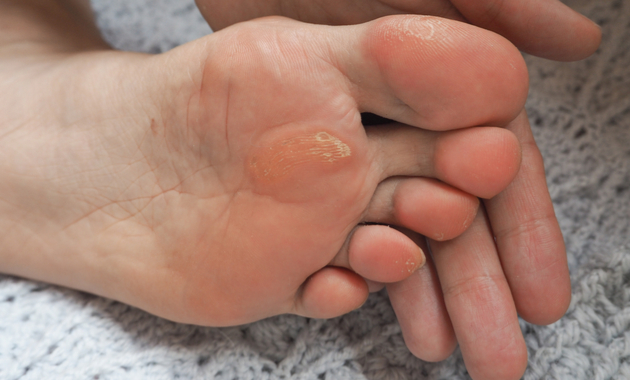
Corns and calluses are thick hardened layers of the skin that are caused due to excessive chronic pressure and friction of the skin. These are mostly found on the feet and toes or hands and fingers and can cause pain or discomfort when you walk. You are at a risk of suffering from corns and calluses if you are an athlete, suffer from diabetes, or are old.
How Do You Get Rid Of Corns And Calluses?
The treatment of corns and calluses is aimed at reducing the pain and discomfort caused by the condition. If these tips fail to provide any relief, then surgery is the only option. According to the American Academy of Dermatology, here are few tips that dermatologists recommend to treat corns and calluses at home.
1. Use pumice stone
First, soak your feet in warm water for about five to ten minutes. Once the skin softens, file the corns or calluses with the help of a pumice stone. Dip the pumice stone in warm water before using it. When using the stone to file, gently rub in sideways or circular motions to get rid of dead skin. When doing so, try not to take off too much of skin as it can cause bleeding and make the area prone to infections.
People with diabetes should take special precautions while using a pumice stone to prevent foot injuries. According to the American Diabetes Association, using a pumice stone on a daily basis can help keep calluses under control. However, ensure you use it on wet skin and apply a lotion after using it to keep the skin soft.
2. Wear shoes that fit properly
One of the most common causes of corns and calluses is wearing ill-fitting shoes which puts pressure on toes thereby increasing the risk. Buy shoes that give your toes plenty of room but fit snugly enough so the shoe does not come off while walking. But if you are not able to wiggle your toes, then it means your shoes are too tight. Make sure your shoes are the right size and shape. Also, it is advised to shop for shoes at the end of the day as the feet may be slightly swollen and help you to get the right fit.
3. Use padding and footgear
There are numerous over the counter treatment options available to get rid of corns and calluses. These include corn plasters, pads, and supports. Plasters are adhesive pads that when applied over the corns prevents direct contact of the skin with the shoes. When these plasters are placed over calluses, it prevents further irritation of the skin. You can also use cloth tapes or covers to support your feet. However, talk to your doctor before using them, as these might not be a good choice for people with diabetes, sensitive skin, or circulatory problems.
4. Use corn caps
Corn caps look like a bandage. The center of which contains the medicine. All you have to do is wrap it around the corn and let it remain for a week. You can remove the cap after a week as the area becomes pale and it becomes easy to remove corns and calluses. However, if you are a diabetic, then using corn caps to remove corns and calluses is not advised. This is because, the chemicals can burn the skin, which in turn, can increase the risk of infections and ulcers.
5. Apply moisturizer every day
As corns and calluses are hard, thickened skin, it is advised to apply moisturizer every day as it makes the skin soft and supple. This not only prevents the skin from becoming hard but also acts as an effective remedy to prevent the recurrence of corns and calluses. Moreover, applying moisturizer prevents the skin from becoming dry, which in turn can lead to infections. Look for moisturizing creams or lotions that contain ingredients such as salicylic acid, ammonium lactate, or urea.
Always Provide Initial Assistance Of Injury Or Illness With These Must Have First Aid Supplies
6. Trim your toenails
If you have long toenails, then it is advised to keep your toenails trimmed. This is because long toenails can put pressure on the surrounding area when pushed up by the shoes. This, in the long run, can increase the risk of suffering from corns and calluses. Moreover, if you already suffer from this condition, then it can worsen it.
(The article is reviewed by Dr. Lalit Kanodia, General Physician)
Recommended Reads:
Footcare In Diabetes: 9 Tips To Prevent Complications
Happy Feet: 8 Home Remedies To Tackle Foot Odour